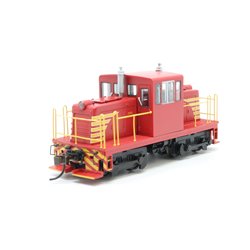Static grass puffer bottles work by manually charging model grass fibres with static electricity. When the charged...
No products
Product successfully added to your shopping cart
There are 0 items in your cart. There is 1 item in your cart.
Search Tips
What is a yard switcher?
A yard switcher, commonly referred to as a shunter in British English, is a type of locomotive specifically designed for shunting operations within railway yards, depots, and industrial sites. Unlike the large, powerful locomotives used for hauling trains over long distances, yard switchers are smaller and more manoeuvrable, making them ideal for moving rail cars within confined spaces. Their primary role is to organise trains by moving individual rail cars or groups of cars to the correct location, whether that be coupling them together to form a train or positioning them for unloading.
Shunters are typically characterised by their robust design, which allows them to perform the frequent starts and stops required in shunting operations. They often feature multiple braking systems to ensure precise control when moving cars, especially in yards where gradients might be present. The engines in these locomotives are usually powerful enough to move heavy loads at low speeds, which is essential when assembling or disassembling trains. Given their specific role, yard switchers are not built for speed but for torque and reliability.
In many UK rail yards, shunters are indispensable due to their versatility. They can operate in various settings, from major freight yards to smaller industrial sidings. Some shunters are even equipped with remote control systems, allowing operators to move rail cars without needing to be in the cab, further increasing their utility. This capability is particularly useful in environments where precision and safety are paramount, such as when positioning cars for loading or unloading hazardous materials.
Historically, British railways have employed various types of shunters, from steam-powered locomotives in the early days of rail transport to more modern diesel and electric models. Diesel shunters, in particular, became widespread in the mid-20th century due to their greater efficiency and lower operating costs compared to steam engines. Today, while some older models remain in use, many yards have upgraded to more advanced and environmentally friendly shunters that produce fewer emissions.
The importance of yard switchers in the overall railway system cannot be overstated. They play a critical role in ensuring the smooth and efficient operation of rail services by maintaining the organisation and readiness of trains. Without shunters, the process of assembling freight trains, organising passenger coaches, or even managing the daily flow of rail traffic would become significantly more challenging and time-consuming.
In addition to their industrial roles, shunters often hold a place in the hearts of railway enthusiasts. Their unique design and the skill required to operate them have made them a popular subject for model railway builders and train spotters alike. Many heritage railways in the UK also preserve and operate historic shunters, providing a glimpse into the operational history of British railways.
Overall, while yard switchers or shunters may not be as glamorous as the locomotives pulling express trains, their role is vital to the functioning of the railway system. They ensure that everything runs smoothly behind the scenes, making them an indispensable part of the railway infrastructure.
Click here to receive the tips weekly in your mailbox. You can unsubscribe at any time.









